.png?width=700&auto=webp&quality=80&disable=upscale)
Checkout: Nourish + Bloom expands fresh, affordable options with AI technologyCheckout: Nourish + Bloom expands fresh, affordable options with AI technology
Realizing their Atlanta suburb needed a grocery store that offers nutritious foods, the Hemmings family incorporates AI to make their venture accessible to everyone, all the time. Find out how they did it.
January 17, 2025
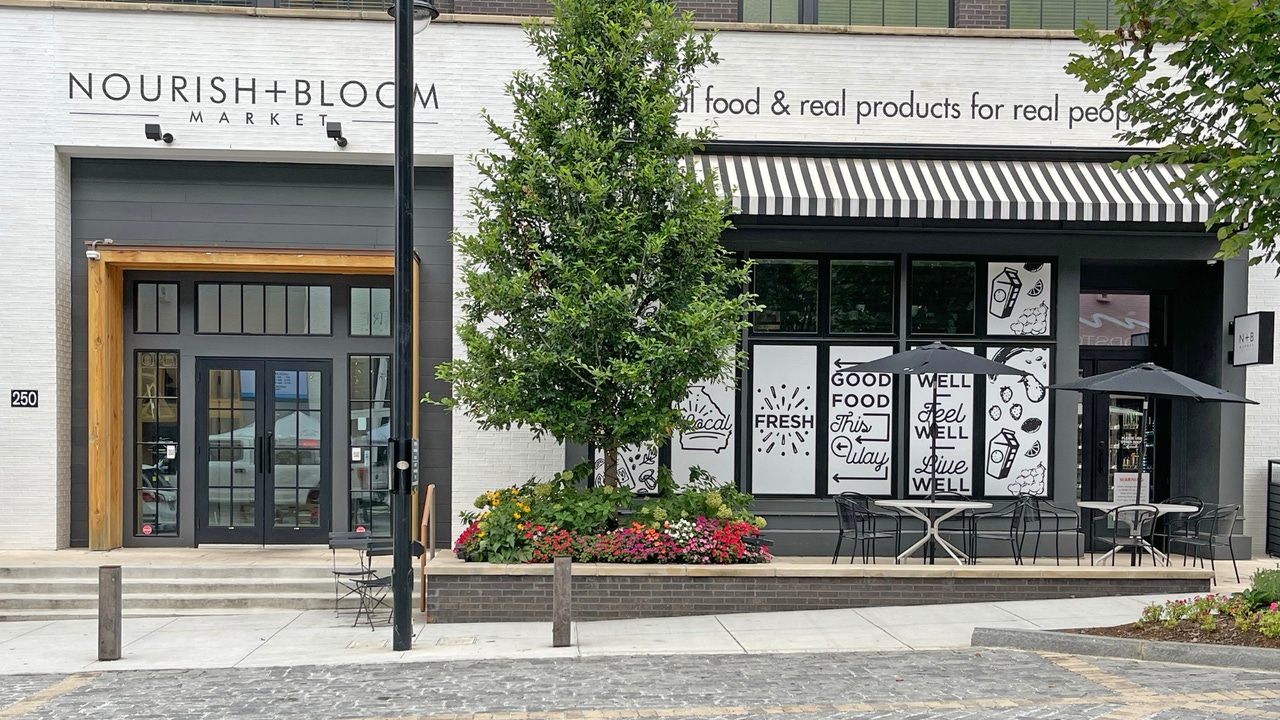
At a Glance
- Nourish + Bloom’s AI technology provides frictionless checkout and round-the-clock access to natural foods.
- AI technology, smart fridges and franchising enable Nourish + Bloom to shape the future of independent grocery retail.
- This Atlanta-area retailer fills a community need, supports local farmers and delivers nutritious, natural foods.
Trilith may be a gorgeous new residential community in suburban Atlanta, but it still lacked something significant: convenient access to affordable, high-quality food. Not anymore, though. Since its January 2022 launch, Nourish + Bloom Market has provided farm-fresh local produce and meats, nutritious natural foods, conventional favorites and bistro meals in a clean, comfortable, tech-enabled space. Notably, thanks to AI-driven frictionless checkout, which even accepts EBT, the company’s flagship store is open 24/7.
Nourish + Bloom is the brainchild of Jilea and Jamie Hemmings, parents of three teenagers and seasoned entrepreneurs who are passionate about expanding food access and supporting local ecosystems—and harnessing technology to drive both missions. The Trilith market represents just the start of their ambitions. Here, Natural Foods Merchandiser chats with Jilea Hemmings about this innovative company and how AI can advance grocery for the good of all.
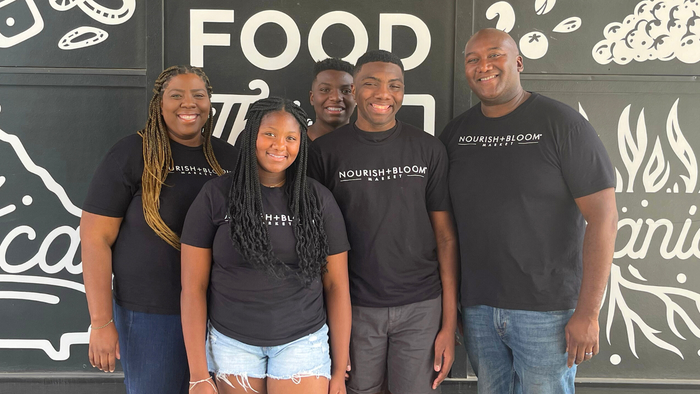
Jilea Hemmings, left, and Jamie Hemmings, right, stand with their three children in front of the side wall of Nourish + Bloom.
Seeding Nourish + Bloom
What was your work experience before Nourish + Bloom?
Jilea Hemmings: I started my career in corporate, in healthcare business development. When my son was diagnosed with autism at age 2, I got into the food space because [nutrition] was the most modifiable risk factor to help him. My husband and I were looking for healthy meals, but we were both in corporate America, so we were like, “we have no time to make this!” But this was our son, so we did it. We started making healthy, meatless meals based on traditional kids’ favorites. That turned into Greenie Tots, our first real entrepreneurial journey into the food space.
What was it like building a food brand?
JH: We started selling these meals in South Florida, where we lived, in the heat of summer at farmers markets. With a frozen product, that wasn’t the most conducive environment. Then we got into retail, starting with six Whole Foods stores, then quickly the whole region, then national distribution. We were in over 143 doors around the country, which was amazing because we were the first to make meatless meals for kids. So that jumped me into the grocery space. Jamie worked on the distribution side for UNFI for a bit, so he had that experience.
Did you sell off that business?
JH: No, we didn’t sell it. We had a bad investor. We had scaled all over the country and thought we had the perfect investor, but then the guy disappeared like a ghost! We had to close down just from a funding perspective. I wrote a whole book about it, The Untold Truth About Building a Startup: 17 Lessons Every Entrepreneur Needs to Know. But we still own all of the IP and recipes, so now we’re incorporating them into our prepared meals at Nourish + Bloom Markets.
What came after Greenie Tots?
JH: We left the grocery space and probably vowed to never go back. We moved to Chicago and got into the tech world and the cannabis business, the health piece of it. We created an app that supported access to licensed dispensaries and medical information. Then right before the pandemic hit, my cousin and I decided to raise our kids together in Atlanta.
Tell us about Trilith, where you ended up moving.
JH: Trilith is a neighborhood within Fayetteville, a suburb of Atlanta. Trilith Studio is now the largest movie studio in the country, and they built a whole town to support the movie studio so that folks wouldn’t have to commute. We are the grocery store for this town.
Wait, in a planned residential community, there was no grocery store before Nourish + Bloom?
JH: Our kids were going to school in the neighborhood, and there was no place to feed them. Obviously, food has always played an important role in our lives, especially for our older son, and we realized this is a food desert. I’ll preface that by saying it’s a beautiful food desert. I think a lot of education [is needed] around what a food desert is supposed to look like.
So that catapulted you back into the food world?
JH: Yes, when the pandemic hit, we saw a huge challenge of people having access to good food options. That, for us, just didn’t sit right, and we knew AI could make a difference. So we looked at our backgrounds in food and tech and realized we could tackle this. So that’s exactly what we set out to do—and to bring this level of innovation to the South. We started in 2020, built it through 2021 and launched in 2022. It has been mission-driven ever since because we’ve seen how much need there is for fresh food all over the country. A lot of work needs to be done.
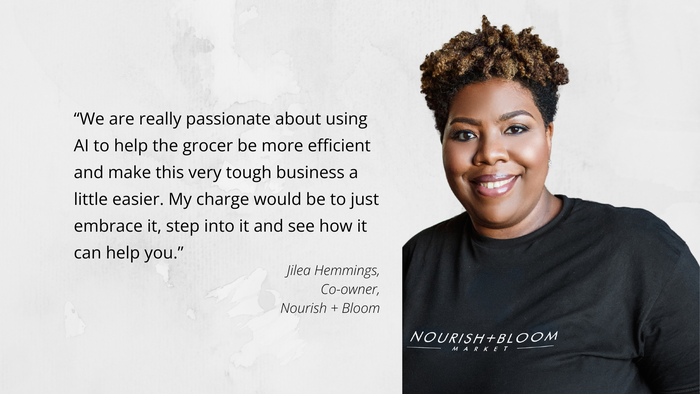
Technology broadens access
OK, Nourish + Bloom Market—what’s your elevator pitch?
JH: We believe that everyone deserves access to good food and we provide 24/7 access with Nourish + Bloom Markets powered by our AI technology.
Did you guys develop the technology or partner with a firm?
JH: Initially, we partnered with a third party to bring the technology and solution to market. Some of the IP was ours, some was theirs. But quickly, we learned that with this technology, certain payment types, like EBT, were not able to be accepted, and that didn’t sit well with us. Going back to our mission of everybody deserves access to good food, we knew we’d have to develop our own solution, so that’s what we did.
Now we are the first in the country to take EBT in frictionless checkout, so we are really excited about that. We can power our stores and also support other markets that want to carry this technology and help them be able accept EBT as well.
Very cool! What’s the rest of the shopping experience like?
JH: Really, our store is a regular grocery store, except there are 50-plus cameras in the ceiling tracking what you pick up and put back so that you don’t have check out. You literally scan in, shop and walk out. Our cameras do all of the checkout work for you.
Do shoppers need to download an app?
JH: You have two ways to shop in our stores. You can download our app and put in your payment, then a QR code will be generated, then you can scan in and shop. Or just tap your card on our tap machine, the doors will open and you can go in, shop and walk out.
Wow, so technology truly is increasing access to good food!
JH: Technology really is changing access. I mean, say you’re a mom like me, who, at 6 a.m., says, “oh my gosh, I forgot to go to the grocery store and I have nothing to feed my kids!” Now I can run in, grab what I need and be back in 10 minutes. Or someone who works third shift and needs access when they get off of work. Providing convenience and healthy options 24/7 is a great thing, and AI has made that possible. AI gets a bad rap, but this is AI for good. It can allow a store to stay open and meet everyone’s needs.
It’s also helping us change the industry. Most stores are going toward self-checkout, and nobody likes it. People are afraid it’s going to take jobs, so we’re also asking what does a new job look like in the grocery space? It’s more of a technical job, and we’re showing that there are many great things about that.
Do your markets have any staff onsite?
JH: Yes, we still have humans there stocking. We have a bistro in our flagship store, so there is someone there during most manned hours, and they are always willing to help. We also have an AI customer experience rep there all of the time, so you can talk to Rosie. And we have all kinds of videos and tutorials. But the store is unmanned for the most part.
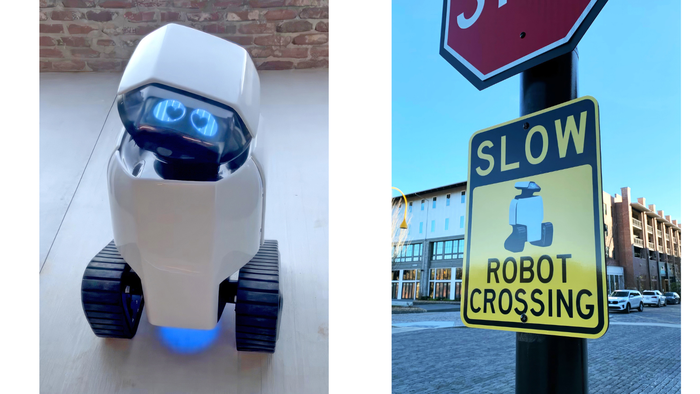
Jilea Hemmings found cute robots to make deliveries within a 3-mile radius, but they were too cute to reach their destinations in time.
And you have robots for delivery?
JH: We had robots. They delivered up to three miles and were great as an entry point to the neighborhood, but they were so popular that they never got anywhere on time. I had thought, OK, if we’re bringing robots and all this crazy technology into a community—like the Jetsons coming to life—then this robot should be friendly. I worked hard to source a cute robot. Kids would hold him and take pictures. That’s great, but it would always be late delivering orders. Then some neighborhood kids broke the robot’s neck.
Alas, RIP robots …
JH: We’re going to bring the robots back, but they’re going to be much less attractive and more utility based. We’re also looking into other methods like drones. I’m always looking at how do we push technology to increase our service area.
Ensuring affordability
How do you keep food affordable?
JH: Food affordability is something I fight all the time, and it’s really challenging. For conventional products, there is no general wholesaler in each city that small grocers can go to for decent pricing so that we can bring decent pricing to our customers. Think about UNFI—there is no conventional version of UNFI.
So, what we do to offset that difference is choose a local vendor before a national supplier, as long as they are ready to go into retail. We go direct to local farms and figure out how to support those ecosystems and take out the middleman to bring down our pricing.
Sourcing from multiple local vendors is a lot of work, so kudos to you!
JH: I was a local vendor, so I know that world. I have compassion for local brands because I know what it takes and how hard it is. But I also know that the quality is better than anything on a national level. So we’re willing to take on the additional work to get the best products for our customers and support the local ecosystem.
Do you offer private-label products?
JH: Yes, we’re also going to roll out basics like rice [under] our own private label to help offset the costs. But until that is possible, we give a deep discount on essentials like milk, eggs and bread. We’re taking a loss on those products, but [ensuring access] is an important part of this business, so that’s something we have chosen to do. Things that are more elective, such as kombucha, will be full price, but milk will be as close to a big-box store’s pricing as possible.
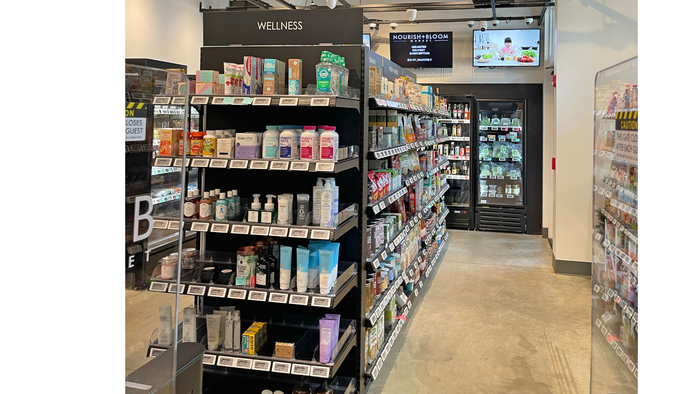
The cameras that track what a shopper removes or returns to the store's shelves are positioned on the ceiling.
Nourish, bloom, flourish
Have other retailers inquired about licensing your payment technology?
JH: We are just launching that now. I anticipate tremendous interest in this, as well as in the development of all of our new stores. Every store we roll out will have the same ability to accept EBT, and we’re really excited about that. We are opening three more stores this year—in October, November and December. They will not have a bistro, so they will be unmanned.
Will all of your markets be in food deserts?
JH: We will always look to support food deserts. Will we have markets not in food deserts? Absolutely, because it’s about full access. But we’ve taken a stance that food deserts need a lot of help. That is close to my heart, so we will always focus on food deserts + and. So it can be in a mixed-use neighborhood as well as a food desert. We like to have a balance of both.
How do you decide where to put a store?
JH: We get a tremendous amount of demand from all over the country. There is just such a need, as one in eight [people in the U.S.] lives in a food desert. So it’s about working with cities and figuring out what level of infrastructure we can deploy. Atlanta has been an amazing place to launch. They understand that there is a huge need and have helped us support food deserts on the west side of Atlanta.
But we’re always taking feedback from our customers and asking where they’d like to see new locations. We look at how we can provide the most value, be that bridge between the big-box store and the corner store and really grow with communities.
Will this be a franchise model?
JH: Yes! That opportunity will become available soon. There is a long list of those who are interested in franchising. Our first four stores are corporately owned just to build out all different store types. We wanted to make sure we did it first to help our franchisees become more successful.
You also have other options besides full stores, right?
JH: We are looking at different ways to deploy, so it can be a full store or a micro market that can go inside an existing building. We also do smart fridges, which are great for schools, parks, universities, offices, you name it. We just placed smart fridges in Mercedes-Benz Stadium, which is amazing that they are supporting their employees. We are taking the grocery experience and bringing it to all types of settings, so that you can have access to better food options 24/7, no matter where you are.
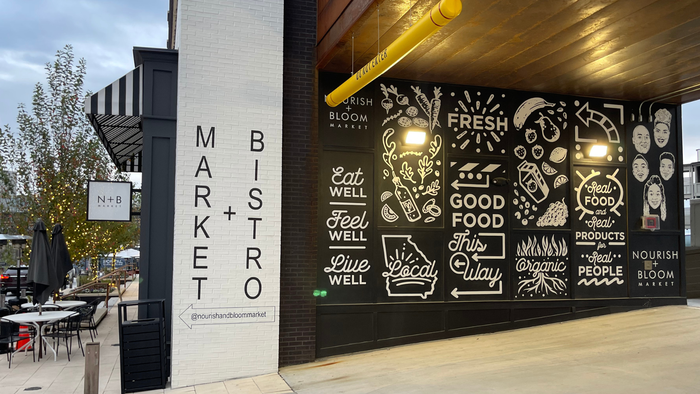
Investing in the future
You and Jamie appeared on “Shark Tank” in March. What was that like?
JH: It was a full-circle moment. When we had Greenie Tots, we were finalists for “Shark Tank.” But we thought our investor was going to give us more than what we were going to ask for on the show, so we told “Shark Tank” no. Then when he disappeared, it was like oh my gosh, we could’ve been on the show! “Shark Tank” gave us another shot, but then cut us from the show list. Jamie and I were devastated.
But this time “Shark Tank” found us. I would’ve never even thought Nourish + Bloom was a “Shark Tank” business, but they wanted to put us on the show! And that was like, oh my gosh, how amazing is it that less than 10 years later, it came back around!?
Despite not landing a shark, was the experience worth it?
JH: While the sharks didn’t understand what we’re doing, we got amazing feedback. It reinforced that what we’re doing makes sense, and it was great exposure. We definitely plan on having a follow-up story to share our success!
What is your biggest challenge right now?
JH: Distribution. We have our farm-based products—produce, meats—under control. And with UNFI as a partner, we have natural taken care of. The conventional side is a sticking point. How do we get better pricing and support our customers with the items they’re looking for?
Also, grocery has historically not been a sexy business to invest in, but we’ve really flipped it on its head by utilizing technology to increase margins with the efficiencies it provides. So, we’re always looking for funding to help with our continued expansion.
Now almost three years into Nourish + Bloom, what are your biggest learnings?
JH: Grocery is a really tough space. But I know that we are providing nourishment, especially for those who need it most, and that’s our biggest driver. That gets us up every morning and gets us through the tough days to fight for the next day. And because our technology is innovative, it has given us a platform. I feel like it’s my job to share how amazing this technology is, but also to talk about the challenges that small and medium-sized grocers go through—and hopefully help them think about solutions.
Any advice for grocers who may be trepidatious about technology?
JH: It’s important to know that there are many ways to maintain how your store currently functions while adding in some new advances in technology to help with efficiency. We are really passionate about using AI to help the grocer be more efficient and make this very tough business a little easier. My charge would be to just embrace it, step into it and see how it can help you.
Read more about:
InnovationAbout the Author
You May Also Like



